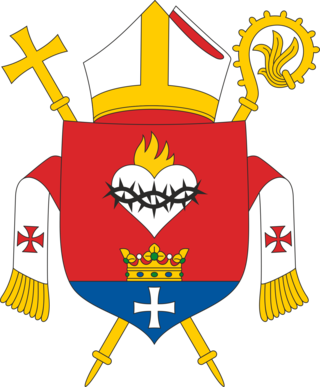
The demographics of Nauru, an island country in the Pacific Ocean, are known through national censuses, which have been analysed by various statistical bureaus since the 1920s. The Nauru Bureau of Statistics have conducted this task since 1977—the first census since Nauru gained independence in 1968. The most recent census of Nauru was on 30 October 2021, when population had reached 11,680 people. The population density is 554 inhabitants per square kilometre, and the overall life expectancy is 63.9 years. The population rose steadily from the 1960s until 2006 when the Government of Nauru repatriated thousands of Tuvaluan and I-Kiribati workers from the country. Since 1992, Nauru's birth rate has exceeded its death rate; the natural growth rate is positive. In terms of age structure, the population is dominated by the 15–59-year-old segment (57%). The median age of the population is 21.6, and the estimated gender ratio of the population is 101.8 males per 100 females.

The Catholic Diocese of Caroline Islands is an ecclesiastical territory or diocese of the Catholic Church in the Federated States of Micronesia and in the Republic of Palau. It is a suffragan diocese of the Ecclesiastical Province of Agaña. The Diocese of Caroline Islands is led by a bishop who pastors the mother church, the Cathedral of the Immaculate Heart of Mary.

The Catholic Church in Fiji is part of the worldwide Catholic Church, under the canonical authority and spiritual leadership of the Pope of Rome.
In the canon law of the Catholic Church, a mission sui iuris, also known as an independent mission, can be defined as: "an ecclesial structure erected from a previous territory, with explicit boundaries, under the care of a religious community or other diocese, responding to a missionary exigency and headed by a superior nominated by the Holy See, under the aegis of the Congregation for the Evangelization of Peoples."

The Ethiopian Catholic Church or Ethiopian Eastern Catholic Church is a sui iuris (autonomous) Eastern Catholic church that is based in Ethiopia. As a particular church of the Catholic Church, it is in full communion with the Holy See. Established in 1930, the church is organised under a metropolitan bishop who exercises oversight of a number suffragan dioceses. In its liturgical services, it uses the Alexandrian Rite in the Ge'ez language.

Nonouti is an atoll and district of Kiribati. The atoll is located in the Southern Gilbert Islands, 38 km north of Tabiteuea, and 250 km south of Tarawa. The atoll is the third largest in the Gilbert Islands and is the island where the Roman Catholic religion was first established in Kiribati, in 1888.

The Roman Catholic Archdiocese of Suva is a Metropolitan Archdiocese in Fiji. It is responsible for the suffragan dioceses of Rarotonga and Tarawa and Nauru and —as of 21 March 2003—the Mission Sui Iuris of Funafuti. The archdiocese was created in 1966, to succeed the Apostolic Vicariate of Fiji.

The Roman CatholicDiocese of Tarawa and Nauru in Kiribati and Nauru is a suffragan diocese of the Archdiocese of Suva. It was erected as the Vicariate Apostolic of Gilbert Islands in 1897, with see in Tanaeang from 1936 to the end of 1950s, and later elevated to as the Diocese of Tarawa in 1966. There was a name change in 1978 and, in 1982, the diocese was split from the Mission sui iuris of Funafuti. The diocese currently has jurisdiction over all of Kiribati and Nauru.

The Mission Sui Iuris of Funafuti is a Catholic Latin mission sui juris in Tuvalu, Polynesia.

Paul Eusebius Mea Kaiuea was a Kiribati Roman Catholic prelate, bishop of the Diocese of Tarawa and Nauru from 1978 to 2020.

Christianity is the predominant religion in Kiribati, with Catholicism being its largest denomination.

Christianity is the largest religion in Nauru, with Nauru Congregational Church being the largest denomination, encompassing 35.71% of the population as of the 2011 census.

The Catholic Church in Kiribati is part of the worldwide Catholic Church, which, inspired by the life, death and teachings of Jesus Christ, and under the spiritual leadership of the Pope and Roman curia in the Vatican City is the largest Christian church in the world. Koru Tito is Bishop of Tarawa and Nauru, with see in Kiribati.
The Episcopal Conference of the Pacific (CEPAC) is the episcopal conference of the Catholic Church that includes the bishops of several islands in Oceania. The CEPAC is a member of the Federation of Catholic Bishops' Conferences of Oceania, FCBCO.

The Sacred Heart Cathedral is a religious building of the Catholic church that is located in South Tarawa on the atoll of Tarawa part of the island nation of Kiribati in Oceania.
Koru Tito was an I-Kiribati priest of the Roman Catholic Church who was appointed bishop of the Diocese of Tarawa and Nauru on 29 June 2020 but was not consecrated a bishop before his death.
Octave Marie Terrienne MSC was the Roman Catholic bishop of the apostolic vicariate of the Gilbert Islands from 1937 until 1961, when Pierre Guichet succeeded him.
Events in the year 2021 in Kiribati.












